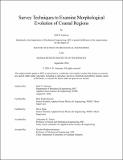| dc.contributor.advisor | Raubenheimer, Britt | |
| dc.contributor.advisor | Elgar, Steve | |
| dc.contributor.author | Ammons, Seth N. | |
| dc.date.accessioned | 2024-10-09T18:24:08Z | |
| dc.date.available | 2024-10-09T18:24:08Z | |
| dc.date.issued | 2024-09 | |
| dc.date.submitted | 2024-09-25T15:57:05.476Z | |
| dc.identifier.uri | https://hdl.handle.net/1721.1/157143 | |
| dc.description.abstract | Beaches are dynamic, changing with tides, winds, and waves. Here, a beach was mapped daily for 3 weeks from the dune to the low-tide water line on the Outer Banks of North Carolina at the US Army Corps of Engineers Field Research Facility in Duck. The 22,500 m2 area of interest was surveyed daily by a walker carrying a GPS-equipped backpack and occasionally with a lidar equipped drone. Surveys of the northern region of interest also were collected with a stationary terrestrial lidar mounted on the dune. The observed morphological events include the destruction and formation of a cusp field during which there was 1.4 m of erosion and accretion associated with bays and horns, and the formation over 7 days of a ~1-m high ridge and runnel system. The GPS-equipped backpack apparatus was used as ground truth for estimates made with the lidar systems. Along both cross- and alongshore transects the lidar elevations were within approximately 0.05 m of those estimated by the backpack surveys, with RMS errors less than 0.11 m. | |
| dc.publisher | Massachusetts Institute of Technology | |
| dc.rights | In Copyright - Educational Use Permitted | |
| dc.rights | Copyright retained by author(s) | |
| dc.rights.uri | https://rightsstatements.org/page/InC-EDU/1.0/ | |
| dc.title | Survey Techniques to Examine Morphological Evolution of Coastal Regions | |
| dc.type | Thesis | |
| dc.description.degree | S.M. | |
| dc.contributor.department | Massachusetts Institute of Technology. Department of Mechanical Engineering | |
| mit.thesis.degree | Master | |
| thesis.degree.name | Master of Science in Mechanical Engineering | |
